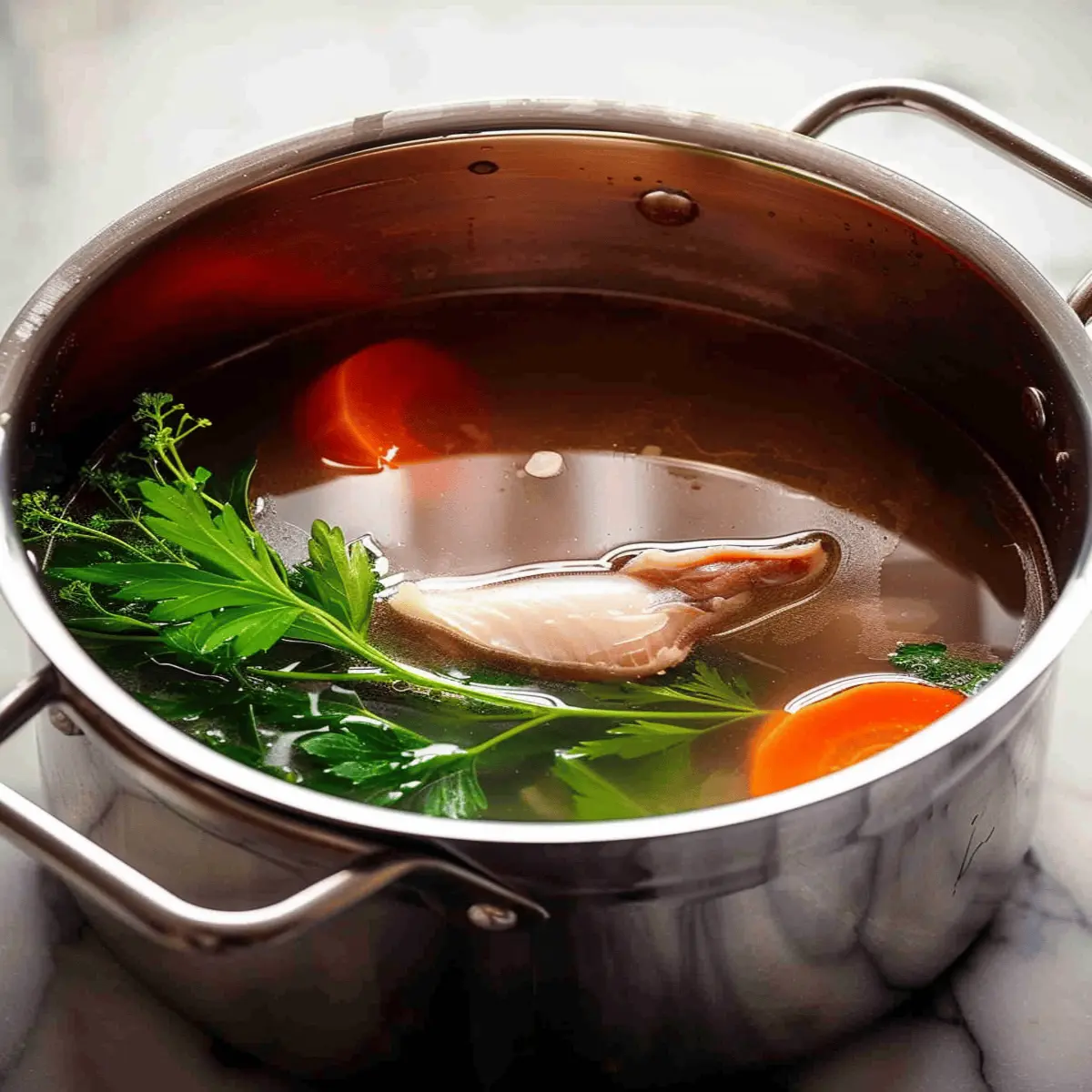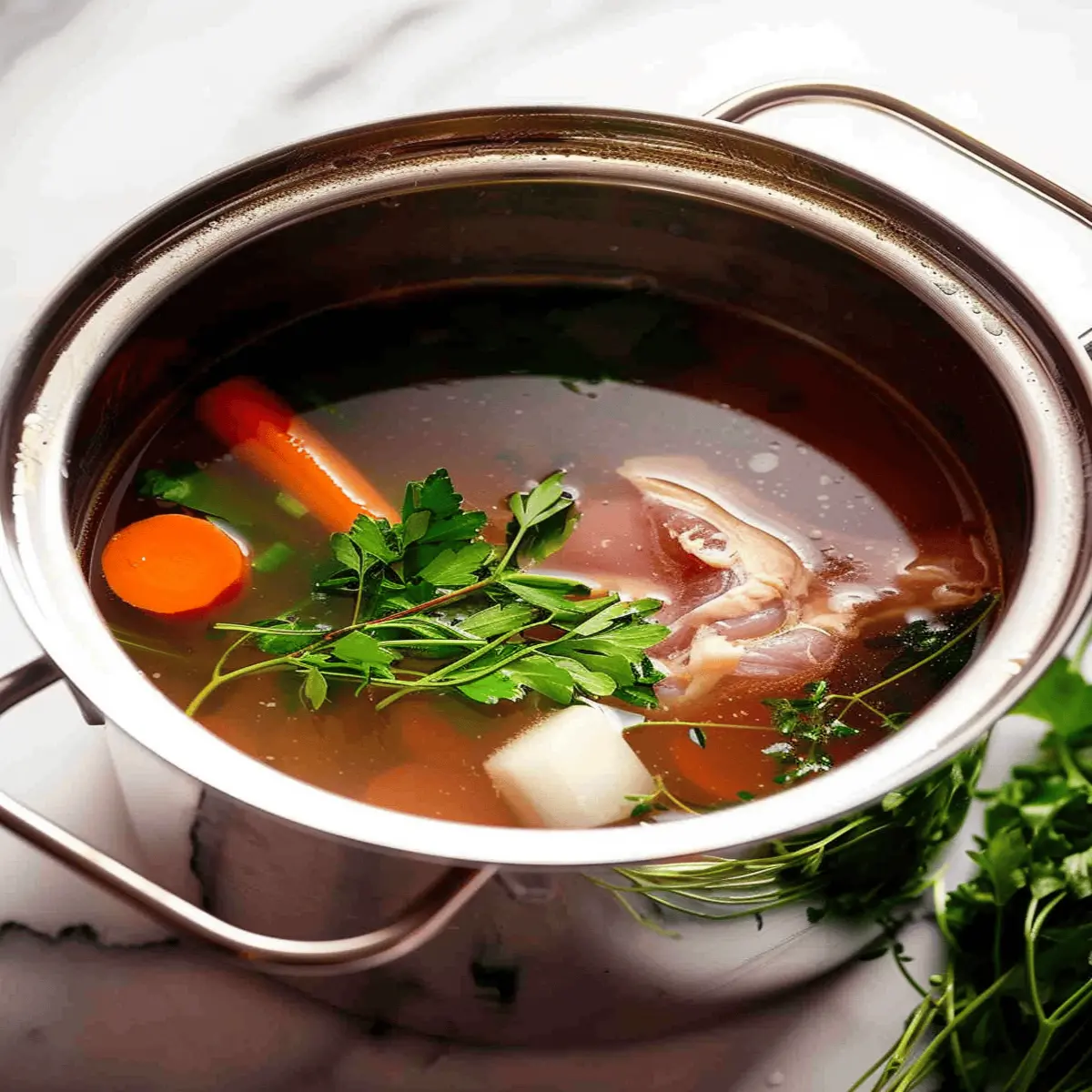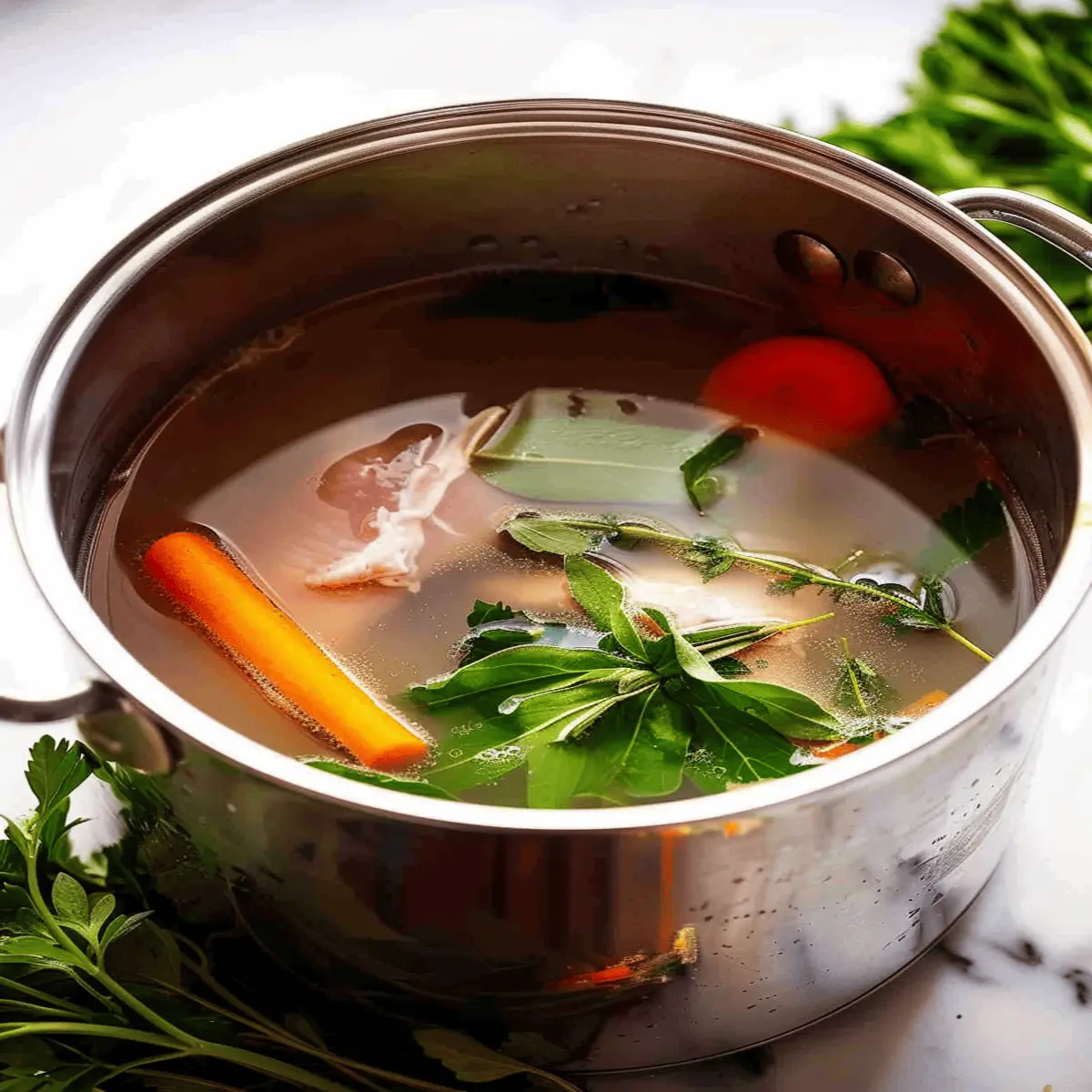Introduction to Chicken Stock
The Comfort of Homemade Chicken Stock
There’s something magical about a pot of homemade chicken stock simmering on the stove. The warmth that fills your kitchen and the rich aroma wafting through the air remind you of cozy family dinners and the love that goes into every pot. Whether you’re nursing a cold, whipping up a comforting soup, or simply looking to elevate your weeknight meals, chicken stock serves as a flavorful foundation for countless dishes.
Using homemade stock can also be a healthier, more cost-effective option than store-bought versions. Did you know that many commercial stocks contain preservatives and artificial flavorings? By making your own, you gain complete control over the ingredients, ensuring that every sip is wholesome and nourishing. You can choose to toss in organic vegetables, fresh herbs, or even grains for added depth. If you’re uncertain about where to start, the USDA offers helpful tips on safe food handling and storage, allowing you to craft the perfect stock.
While the initial prep might seem daunting for young professionals with bustling schedules, think of it this way: making a big batch of chicken stock can be a soothing, even meditative experience. Plus, once you have it on hand, this versatile liquid can elevate countless meals: from risottos to stews, or as a simple base for a fragrant sauce.
A classic tip is to save your vegetable scraps—like onion skins, carrot peels, and celery tops—in the freezer. This doesn’t just cut down on waste; it adds even more flavor to your stock! You may even find yourself getting creative, experimenting with herbs you usually wouldn’t think of using.
So, the next time you find yourself in need of some culinary magic, consider making your own chicken stock. It’s a straightforward process that rewards you with rich, delicious results. Trust me, once you experience the depth of flavor from homemade stock, you won’t want to go back!

Ingredients for Chicken Stock
Basic Ingredients for a Flavorful Stock
When it comes to crafting the perfect chicken stock, less is often more. The foundation of a rich and flavorful stock begins with a few simple yet effective ingredients:
- Chicken Bones: You can use leftover carcasses from roast chicken or buy raw bones. The more marrow, the better your stock will taste. Aim for about 2–3 pounds.
- Water: Start with enough to cover the bones, typically around 8–10 cups.
- Aromatics: A classic combination includes onions, carrots, and celery. One onion (halved), two carrots (chopped), and two celery stalks (chopped) will do the trick.
- Herbs: Fresh thyme, bay leaves, or parsley stems bring a fragrant touch. A couple of sprigs are all you need.
Optional Add-Ins for Extra Depth
Want to elevate your chicken stock even further? Consider these optional additions:
- Garlic: A few cloves can add a robust flavor.
- Mushrooms: Dried or fresh, they introduce an umami richness.
- Peppercorns: A teaspoon of whole peppercorns introduces mild heat and complexity.
Enhancing your stock with these ingredients not only diversifies flavors but also aligns with expert recommendations from culinary sources like Serious Eats. Remember, the beauty of stock lies in its versatility—don’t be afraid to experiment with what you have on hand. How do you like to customize your stock?
Preparing Chicken Stock
Making your own chicken stock is not only a great way to infuse flavor into your dishes but also a perfect opportunity to utilize leftover ingredients you may have lying around. Plus, nothing beats the warmth and comfort of homemade stock! Ready to dive into cooking magic? Let’s get started.
Gather Your Ingredients
Before you can whip up a delicious batch of chicken stock, you’ll need to gather your ingredients. Here’s a handy checklist:
- Chicken parts: A whole chicken, chicken backs, or carcasses are all excellent choices. You can also use leftover bones from a roast chicken.
- Vegetables: Common choices include carrots, celery, onions, and garlic, all of which contribute to the richness of the stock.
- Herbs: Fresh parsley, thyme, or bay leaves are perfect for adding depth.
- Spices: Whole peppercorns and a pinch of salt enhance the flavor.
- Water: You’ll need plenty of this to help extract the chicken’s essence.
When selecting your chicken, opt for organic or free-range options if possible. They not only taste better, but they also yield a richer stock. If you’re interested in nutritional insights, check out the benefits of homemade stock here.
Prepare the Chicken and Vegetables
With your ingredients ready, it’s time to prep them. If you’re using a whole chicken, cut it into parts to help release the flavors better. Here’s how to prepare everything:
- Chicken: Clean it under cold water to remove any residue.
- Vegetables: Chop the carrots, celery, and onions into large chunks. There’s no need for precision; they’ll be strained out later.
- Garlic: Smash a few cloves—don’t bother peeling them. This method releases their oils without adding much fuss to the process.
Don’t hesitate to toss in any leftover vegetable scraps you have. They’ll only enhance the flavor!
Simmering the Stock
Now the fun part: simmering! Place your chicken and chopped vegetables into a large pot. Add about 12-16 cups of water or enough to cover your ingredients fully. Bring it to a gentle boil before reducing the heat to a simmer.
Let it simmer for approximately 4-6 hours, which helps extract all those rich flavors and nutrients. If you have a slow cooker, that’s another excellent option—setting it on low for 8-12 hours will work beautifully.
Fun fact: according to the USDA, homemade stock can maintain its quality in the freezer for up to 6 months. Just remember to label your containers for easy identification later!
Skimming and Straining
As your stock simmers, occasionally skim off any foam or fat that rises to the top. This step improves clarity and flavor. After your stock has simmered to perfection, it’s time to strain it.
Here’s the process:
- Use a fine-mesh strainer: Place it over another pot or bowl.
- Pour the stock: Allow the liquid to filter through, leaving the solids behind.
You can also use cheesecloth for an even clearer stock. Don’t forget to reserve the meat; it can be shredded and used in soups, salads, or tacos!
Storing Your Homemade Chicken Stock
Once your chicken stock is ready, you’ll want to store it properly. Here’s how to do it:
- Cool it down: Allow the stock to cool to room temperature. You can speed this along by placing the pot in a cold water bath.
- Divide into containers: Use airtight containers or freezer bags for storage. Consider portioning it out for convenience—quarts or pints work well.
- Refrigerate or freeze: Stock can be refrigerated for up to 5 days, or frozen for longer storage. Removing air from freezer bags helps prevent freezer burn.
And there you have it—a wholesome, homemade chicken stock that can elevate your cooking game! Why not use your newly perfected stock in soups, risottos, or sauces? The possibilities are endless!
Happy cooking!

Variations on Chicken Stock
When you think of chicken stock, do you picture a simple pot bubbling away on the stove? While classic chicken stock delivers on flavor, there are plenty of exciting variations to elevate your cooking game. Let’s dive into two delightful approaches to create an even more unforgettable stock.
Richer Broth with Roasted Chicken Stock
If you’re craving a deeper, more robust flavor, consider making roasted chicken stock. This variation involves roasting the chicken bones and vegetables before simmering them. Simply:
- Roast bones and a variety of vegetables (think onion, carrot, and celery) in the oven until they develop a golden-brown color.
- Transfer everything to your stockpot and add cold water, herbs, and your choice of seasoning.
- Slowly simmer for several hours.
The roasting process caramelizes the natural sugars in the ingredients, resulting in a rich, complex stock that can take your soups and sauces to the next level. Plus, according to research from The Culinary Institute of America, this method enhances the nutrient profile of your final product.
Herbal Infusions for a Unique Twist
Feeling adventurous? Why not incorporate herbal infusions into your chicken stock? Adding fresh herbs like thyme, rosemary, or even lemongrass during the simmering process can yield a stock that’s bursting with flavor.
- Experiment by adding different herbs based on the dish you’re preparing. For instance, basil gives an Italian flair, while cilantro can take you towards a Mexican vibe.
- Consider using a mix of fresh and dried herbs for a layered flavor experience.
These small tweaks can transform your regular chicken stock into a vibrant backdrop for your culinary creations while offering you the chance to showcase your culinary creativity.
Whether you go for the depth of roasted bones or the bright notes of fresh herbs, these variations will surely impress and enhance your home-cooked meals.
Cooking Tips and Notes for Chicken Stock
Tips for Maximizing Flavor
To truly elevate your chicken stock, think about the ingredients you’re using. A combination of bones, meat, and aromatics can give you fantastic depth. Here are some tips:
- Roast Your Bones: Browning your bones in the oven beforehand adds a rich, savory flavor that makes a world of difference. This step is what chefs swear by—just look at what sources like Serious Eats recommend!
- Herbs and Spices: Toss in a few sprigs of fresh thyme or a bay leaf to enhance the aroma. Keep the seasoning light during cooking, adjusting more at the end.
Perfecting the Consistency
For a well-balanced chicken stock, texture matters just as much as flavor. You want it to be rich, yet not too greasy. Here’s how to get it just right:
- Simmer, Don’t Boil: Keep that stock on a gentle simmer. Boiling can break down the ingredients too quickly, leading to cloudiness.
- Skim the Foam: While your stock is simmering, skim off any foam that rises to the top. This helps keep your stock clear and gives you a cleaner taste.
With these tips, you’ll find making chicken stock an enjoyable and rewarding process!

Serving Suggestions for Chicken Stock
Using Chicken Stock in Soups
When it comes to creating a soul-warming bowl of soup, chicken stock is your secret weapon. Whether you’re whipping up a classic chicken noodle or a vibrant minestrone, using homemade bone broth adds depth and richness that store-bought options simply can’t match. Did you know that homemade stock can be packed with nutrients? According to a study by the National Institutes of Health, bone broth is rich in vitamins and minerals, making it a healthful addition to your meals.
Pro Tips for Soup Success:
- Use the stock as a base for quick weeknight meals.
- Add seasonal vegetables for extra flavor and nutrition.
- Experiment with different herbs and spices.
Base for Sauces and Risottos
Chicken stock isn’t just for soups; it’s a fantastic base for sauces and risottos, providing a rich flavor that elevates your dishes. Instead of water, use stock when making risotto to achieve that creamy consistency that coats each grain beautifully. For sauces, deglaze your pan with stock after searing meat, capturing those delightful browned bits.
Ideas for Sauces:
- Gravy: Whisk in some stock for a sumptuous sauce.
- Pan sauces: Combine with wine and herbs for a gourmet touch.
For some delicious risotto recipes, check out epicurious.com or foodnetwork.com for guidance!
By incorporating chicken stock creatively into your cooking, you can transform simple meals into culinary delights.
Time Breakdown for Making Chicken Stock
Preparation Time
Making chicken stock starts with about 20-30 minutes of preparation. This is the time you’ll spend gathering your ingredients—like vegetables and chicken bones—chopping them, and getting them ready to go. A little organization here goes a long way. You want everything within reach!
Cooking Time
Once you’ve prepped your ingredients, the cooking time is where the magic happens: about 4-6 hours of simmering. This slow process allows all the flavors to meld beautifully, giving you a rich, fragrant stock.
Total Time
In total, you’re looking at roughly 4.5 to 6.5 hours, including preparation and cooking. You might be busy during this time, but don’t worry! Most of it is hands-off, allowing you to multitask or even enjoy a good book while the chicken stock bubbles away.
Want to dive deeper? Check out this article on the Science of Stock for more insights!
Nutritional Facts for Chicken Stock
When whipping up a comforting pot of chicken stock, it’s always great to know what you’re getting health-wise. Here’s a quick rundown of its nutritional profile—perfect for mindful meal planning.
Calories
A typical serving of homemade chicken stock contains about 30-40 calories. This makes it an excellent base for soups and sauces without contributing excess calories to your meal.
Protein
You’ll find that this flavorful broth offers roughly 5 grams of protein per serving. This can be particularly beneficial for those seeking to enhance their protein intake through natural sources.
Sodium
Now, if you’re watching your sodium intake, be aware that homemade chicken stock can be low in sodium, depending on how much salt you add during cooking. Store-bought versions can contain a lot more—up to 800 mg per serving! For more information on sodium consumption, check out the American Heart Association’s guidelines.
With these nutritional facts in mind, you can confidently incorporate chicken stock into your healthy cooking routine, enhancing both flavor and nourishment.
FAQs about Chicken Stock
How long can I store homemade chicken stock?
When it comes to chicken stock, storage is key to preserving its flavor and quality. Typically, homemade stock can last in the refrigerator for about 3 to 4 days. To keep it fresh, ensure it’s stored in an airtight container. If you notice any odd smells or flavors, it’s best to toss it out. Remember, safety first!
Can I freeze chicken stock?
Absolutely! Freezing chicken stock is a fantastic way to extend its shelf life. You can keep your stock in the freezer for up to 6 months—just be sure to leave some headspace in your container to allow for expansion. Alternatively, ice cube trays are a clever option for portioning out stock—perfect for adding a few cubes to sautéed veggies or sauces. For more freezing tips, consider checking out resources at The Kitchn.
What’s the difference between stock and broth?
While many people use the terms interchangeably, there’s a slight distinction. Chicken stock is usually made from simmering bones, which gives it a rich flavor and a gelatinous texture due to the collagen extracted from the bones. Broth, on the other hand, typically refers to a liquid made by simmering meat, often with some bones, resulting in a lighter taste and body.
So, next time you’re at the grocery store, or whipping up a soup, you’ll know exactly what you’re reaching for! Why not dive into the world of homemade chicken stock and elevate your cooking game? Happy cooking!
Conclusion on Chicken Stock
The Value of Homemade Chicken Stock in Your Kitchen
Making your own chicken stock is not just a culinary endeavor; it’s an investment in flavor, health, and sustainability. When you create stock at home, you’re controlling the ingredients, ensuring a rich source of nutrients without the preservatives often found in store-bought versions. This versatile base enhances not just soups and stews but also risottos, sauces, and more.
By incorporating leftover bones and vegetables, you reduce waste and add depth to your cooking. Plus, there’s something incredibly rewarding about simmering a pot of goodness that fills your kitchen with warmth. Are you ready to elevate your culinary game? Dive into homemade chicken stock today! Check out more about the benefits of homemade stocks at ChefSteps or Serious Eats for expert advice.
PrintChicken Stock Magic: Unleash Bold Flavors in Your Meals
Discover the secrets to making rich and flavorful chicken stock that will enhance all your meals.
- Prep Time: 20 minutes
- Cook Time: 6 hours
- Total Time: 6 hours 20 minutes
- Yield: 12 cups 1x
- Category: Sauces
- Method: Simmering
- Cuisine: American
- Diet: Gluten-Free
Ingredients
- 1 whole chicken, preferably organic
- 2 carrots, chopped
- 2 celery stalks, chopped
- 1 onion, quartered
- 4 cloves garlic, smashed
- 1 bay leaf
- 10 peppercorns
- 2 teaspoons salt (adjust to taste)
- 12 cups water
Instructions
- Place the chicken in a large stock pot.
- Add the carrots, celery, onion, garlic, bay leaf, peppercorns, and salt.
- Pour in the water until the chicken is fully submerged.
- Bring to a boil over high heat, then reduce to a simmer.
- Cover and let simmer for 4-6 hours, skimming off any foam that rises to the top.
- Remove the chicken and strain the stock through a fine-mesh sieve.
- Let the stock cool before storing it in the refrigerator or freezer.
Notes
- For enhanced flavor, roast the chicken and vegetables before adding them to the pot.
- Adjust the salt to your taste.
Nutrition
- Serving Size: 1 cup
- Calories: 50
- Sugar: 0
- Sodium: 400
- Fat: 2
- Saturated Fat: 0.5
- Unsaturated Fat: 1.5
- Trans Fat: 0
- Carbohydrates: 1
- Fiber: 0
- Protein: 9
- Cholesterol: 45
Keywords: Chicken Stock, Broth, Cooking, Flavor Enhancer













